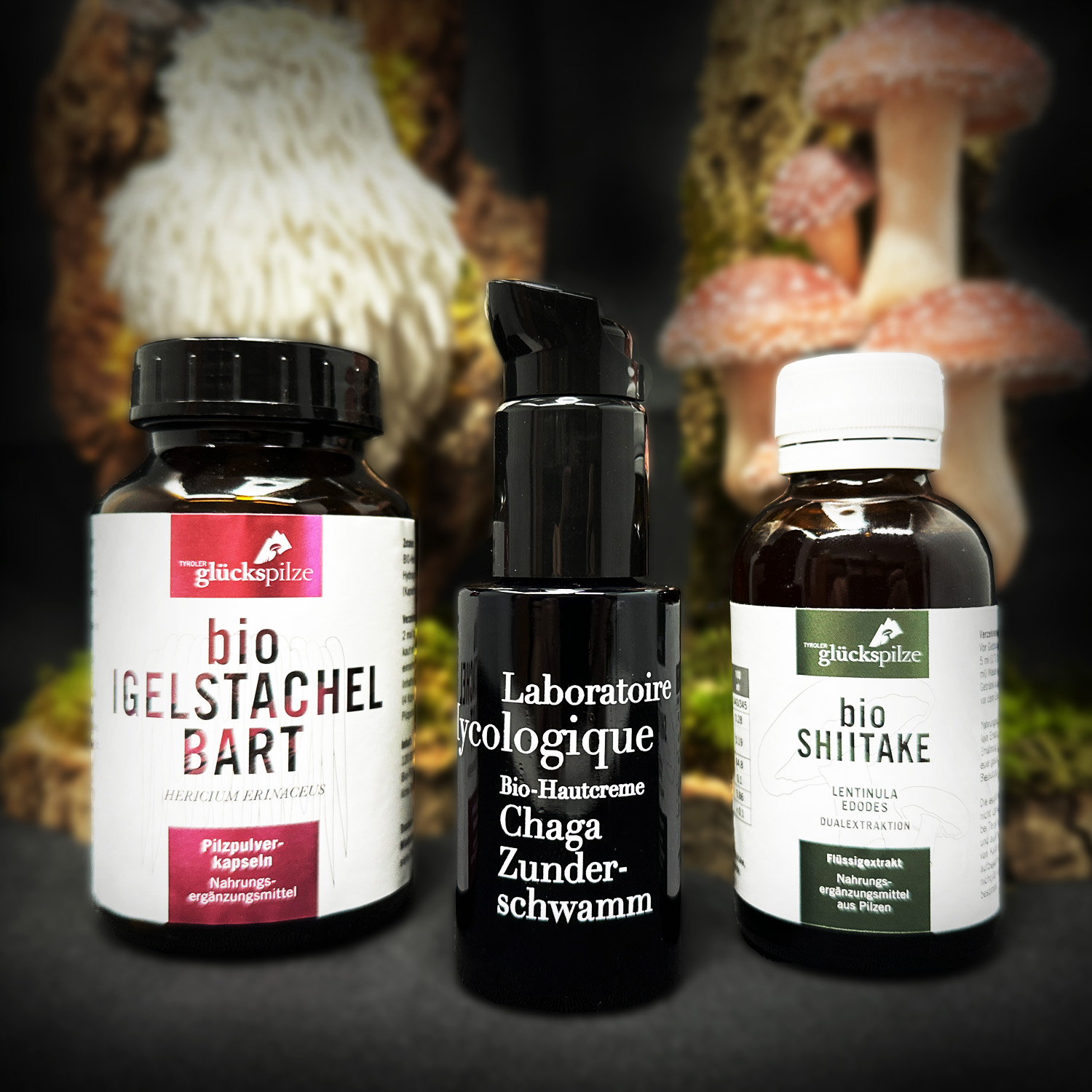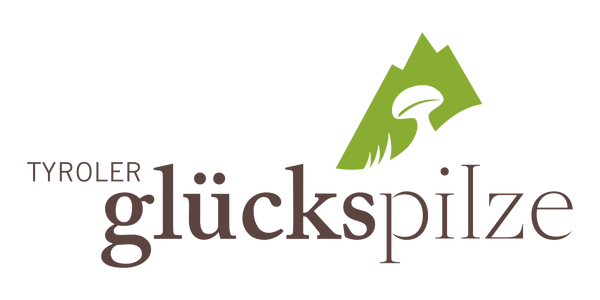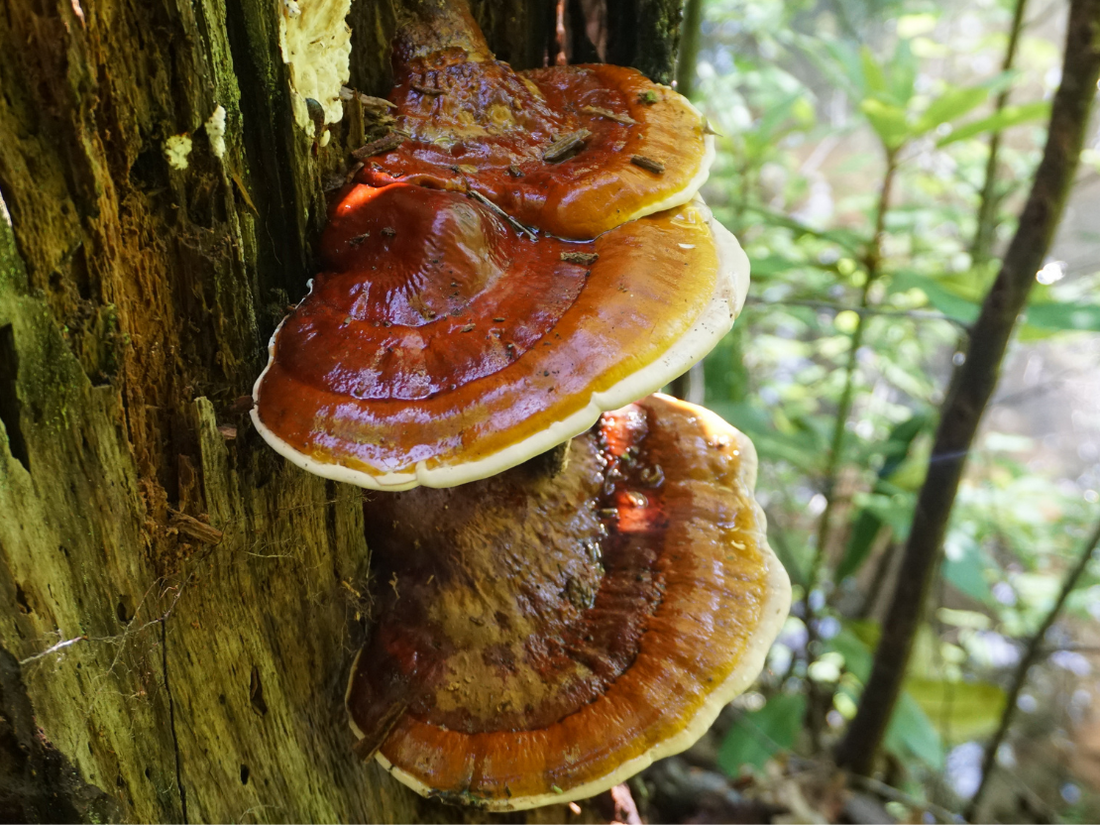This mushroom is called Ling Zhi in China and Reishi in Japan. Tradition has it that this fascinating mushroom has a history of around 4,000 years! In East Asia, Reishi is traditionally a symbol of health, physical and mental recovery, long life, high sexual activity, wisdom and wealth. Reishi is rich in micronutrients such as iron, magnesium, calcium, zinc, copper, manganese and germanium. The polysaccharides and triterpenes contained in Reishi, such as ganodermic acids, ganolucidic acids and lucidemic acids, are particularly valuable.
Synonyms: Reishi, Ling Zhi / Ling Chi, Shiny Lackporling, Mannentake, Ten Thousand Year Mushroom
Distribution and habitat in nature: Ganoderma lucidum is a wood-dwelling saprophyte that primarily colonizes hardwoods such as oak, beech, alder or birch. It prefers warm oak or mixed oak forests, as well as copper beech forests or hardwood floodplains. But it can also be found in hedges, in parks and on roadsides if the appropriate conditions are met. It is particularly widespread in Mediterranean and temperate areas; in Europe it occurs as far as southern Scandinavia. In Germany and Austria, the Shiny Lackporling is distributed in different densities throughout the entire area.
Use: Medicinal mushroom
Ingredients: including polysaccharides, triterpenes, ganoderans, B, D and E vitamins, iron, magnesium, copper, zinc, germanium
Traditional areas of application:
- Accompanying cancer therapy (1-15)
- Allergies (16-20)
- liver strengthening (21-29)
- High blood pressure (30.31)
- Insomnia (32-34)
- Articular rheumatism (35)
- Anti-aging (36-40)
- Stimulating the immune system (41-45)
- Prevention of cardiovascular diseases (46, 47)
Its immunomodulating and anti-inflammatory effects make Ganoderma lucidum an ideal remedy against allergies (see Ganoderma lucidum (16 - 20)).
Ganoderma lucidum has a broad effect on the health of the heart and blood vessels. Polysaccharides and triterpenes isolated from Ganoderma lucidum showed hypolipidemic, antithrombotic and antihypertensive effects and reduced heart palpitations and shortness of breath. (see Ganoderma lucidum (30, 31))
The traditional name “mushroom of the mind” already indicates the calming effect of the triterpenes contained in Ganoderma lucidum on the CNS; many healers value it in cases of insomnia (see Ganoderma lucidum (32 - 34)).
In cases of rheumatoid arthritis, the combination of immune-modulating and anti-inflammatory effects inherent in Ganoderma lucidum can develop its great potential. A proteoglucan fraction from Ganoderma lucidum was shown to have an inhibitory effect on the pathological changes in joint fibroblasts in vitro (see Ganoderma lucidum (35)).
Scientific Studies on Reishi:
1) Anticancer effects of Ganoderma lucidum : a review of scientific evidence. Yuen JW, Gohel MD Nutr Cancer. 2005;53(1):11-7.
2) Regression of gastric large B-cell lymphoma accompanied by a florid lymphoma-like T-cell reaction: immunomodulatory effect of Ganoderma lucidum (Lingzhi)? Cheuk W, Chan JK, Nuovo G, Chan MK, Fok M. Int J Surg Pathol. 2007;15(2):180-6.
3) Potential of a novel polysaccharide preparation (GLPP) from Anhui-grown Ganoderma lucidum in tumor treatment and immunostimulation. Pang X, Chen Z, Gao X, Liu W, Slavin M, Yao W, Yu LL J Food Sci. 2007;72(6):S435-42.
4) Cytotoxic triterpenoids from Ganoderma lucidum . Cheng CR, Yue QX, Wu ZY, Song XY, Tao SJ, Wu XH, Xu PP, Liu X, Guan SH, Guo DA Phytochemistry. 2010;71(13):1579-1585.
5) Triterpenes from Ganoderma lucidum induce autophagy in colon cancer through the inhibition of p38 mitogen-activated kinase (p38 MAPK). Thyagarajan A, Jedinak A, Nguyen H, Terry C, Baldridge LA, Jiang J, Sliva D. Nutr Cancer. 2010;62(5):630-40.
6) Ganoderic acid T inhibits tumor invasion in vitro and in vivo through inhibition of MMP expression. Chen NH, Liu JW, Zhong JJ Pharmacol Rep. 2010;62(1):150-63.
7) Inhibitory effects of ganoderma lucidum on tumorigenesis and metastasis of human hepatoma cells in cells and animal models. Weng CJ, Chau CF, Yen GC, Liao JW, Chen DH, Chen KD J Agric Food Chem. 2009;57(11):5049-57.
8) Cytotoxic lanostanoid triterpenes from Ganoderma lucidum. Guan SH, Xia JM, Yang M, Wang XM, Liu X, Guo DA J Asian Nat Prod Res. 2008;10(7-8):705-10.
9) The anti-invasive effect of lucidenic acids isolated from a new Ganoderma lucidum strain. Weng CJ, Chau CF, Chen KD, Chen DH, Yen GC Mol Nutr Food Res. 2007;51(12):1472-7.
10) Lucidenic acids P and Q, methyl lucidenate P, and other triterpenoids from the fungus Ganoderma lucidum and their inhibitory effects on Epstein-Barr virus activation. Iwatsuki K, Akihisa T, Tokuda H, Ukiya M, Oshikubo M, Kimura Y, Asano T, Nomura A, Nishino HJ Nat Prod. 2003 Dec;66(12):1582-5.
11) Suppression of the inflammatory response by triterpenes isolated from the mushroom Ganoderma lucidum . Dudhgaonkar S, Thyagarajan A, Sliva D. Int Immunopharmacol. 2009;9(11):1272-80.
12) Ganoderma lucidum suppresses motility of highly invasive breast and prostate cancer cells. Sliva D, Labarrere C, Slivova V, Sedlak M, Lloyd FP Jr, Ho NW Biochem Biophys Res Commun. 2002;298(4):603-12.
13) Ganoderma lucidum suppresses growth of breast cancer cells through the inhibition of Akt/NF-kappaB signaling. Jiang J, Slivova V, Harvey K, Valachovicova T, Sliva D. Nutr Cancer. 2004;49(2):209-16.
14) Effects of ganopoly (a Ganoderma lucidum polysaccharide extract) on the immune functions in advanced-stage cancer patients. Gao Y, Zhou S, Jiang W, Huang M, Dai X. Immunol Invest. 2003;32(3):201-15.
15) Effects of water-soluble Ganoderma lucidum polysaccharides on the immune functions of patients with advanced lung cancer. Gao Y, Tang W, Dai X, Gao H, Chen G, Ye J, Chan E, Koh HL, Li X, Zhou S. J Med Food. 2005;8(2):159-68.
16) Anti-allergic constituents in the culture medium of Ganoderma lucidum. (I). Inhibitory effect of oleic acid on histamine release. Tasaka K, Akagi M, Miyoshi K, Mio M, Makino T. Inflammation Research. 1988;23(3-4):153-6
17) Anti-allergic constituents in the culture medium of Ganoderma lucidum. (II). The inhibitory effect of cyclooctasulfur on histamine release. Tasaka K, Mio M, Izushi K, Akagi M, Makino T. Inflammation Research. 1988;23(3-4):157-60.
18) Effectiveness of Dp2 nasal therapy for Dp2-induced airway inflammation in mice: using oral Ganoderma lucidum as an immunomodulator. Liu YH, Tsai CF, Kao MC, Lai YL, Tsai JJ J Microbiol Immunol Infect. 2003;36(4):236-428.
19) The use of Ganoderma lucidum (Reishi) in the management of histamine-mediated allergic reactions. Powell M. Nutritional Practitioner Magazine. October 2004
20) The Chinese herbal medicine formula FAHF-2 completely blocks anaphylactic reactions in murine model of peanut allergy. Srivastava KD, Kattan JD, Zou ZM, Li JH, Zhang L, Wallenstein S, Goldfarb J, Sampson HA, Li XM J Allergy Clin Immunol. 2005;115(1):171-8.
21) Antimutagenic activity of methanolic extract of Ganoderma lucidum and its effect on hepatic damage caused by benzo[a]pyrene. Lakshmi B, Ajith TA, Jose N, Janardhanan KK J Ethnopharmacol. 2006;107(2):297-303.
22) Effects of Ganoderma lucidum polysaccharide on CYP2E1, CYP1A2 and CYP3A activities in BCG-immune hepatic injury in rats. Wang X, Zhao X, Li D, Lou YQ, Lin ZB, Zhang GL Biol Pharm Bull. 2007;30(9):1702-6.
23) Post-treatment of Ganoderma lucidum reduced liver fibrosis induced by thioacetamide in mice. Wu YW, Fang HL, Lin WC Phytother Res. 2010;24(4):494-9.
24) In vitro and in vivo protective effects of proteoglycan isolated from mycelia of Ganoderma lucidum on carbon tetrachloride-induced liver injury. Yang XJ, Liu J, Ye LB, Yang F, Ye L, Gao JR, Wu ZH World J Gastroenterol. 2006;12(9):1379-85.
25) Antifibrotic effects of a polysaccharide extracted from Ganoderma lucidum , glycyrrhizin, and pentoxifylline in rats with cirrhosis induced by biliary obstruction. Park EJ, Ko G, Kim J, Sohn DH Biol Pharm Bull. 1997;20(4):417-20.
26) Ganoderma lucidum extract attenuates the proliferation of hepatic stellate cells by blocking the PDGF receptor. Wang GJ, Huang YJ, Chen DH, Lin YL Phytother Res. 2009;23(6):833-9.
27) Treatment of chronic hepatitis B with Wulingdan Pill . Journal of the fourth Military Medical College. 8:380-383. From Abstracts of Chinese Medicines 2:188
28) Effects of total triterpenoids extract from Ganoderma lucidum (Curt.: Fr.) P. Karst. (Reishi Mushroom) on experimental liver injury models induced by Carbon Tetrachloride or D-Galactosamine in mice. Lin ZB, Wang MY, Liu Q, Che QM Int J Med Mushr. 2002;4(1):37-41
29) Anti-hepatitis B activities of ganoderic acid from Ganoderma lucidum. Li YQ, Wang SF Biotechnol Lett. 2006;28(11):837-41.
30) A phase I/II study of ling zhi mushroom Ganoderma lucidum (W.Curt.:Fr.) Lloyd ( Aphyllophoromycetideae ) extract in patients with coronary heart disease. Gao Y, Chen G, Dai X, Ye J, Zhou S. Int J Med Mushr. 2004;6(4):30
31) Effect of Ganoderma lucidum on the quality and functionality of Korean traditional rice wine, yakju. Kim JH, Lee DH, Lee SH, Choi SY, Lee JS J Biosci Bioeng. 2004;97(1):24-8.
32) A preliminary study on the sleep-improvement function of the effective ingredients of Ganoderma lucidum fruitbody. Jia W, Wu M, Zhang JS, Liu YF Acta Edulis Fungi. 2005;12(3):43-47
33) Sleep-promoting effects of Ganoderma extracts in rats: comparison between long-term and acute administrations. Honda K, Komoda Y, Inoué S. Tokyo Ika Shika Daigaku Iyo Kizai Kenkyusho Hokoku. 1988;22:77-82.
34) Extract of Ganoderma lucidum potentiates pentobarbital-induced sleep via a GABAergic mechanism. Chu QP, Wang LE, Cui XY, Fu HZ, Lin ZB, Lin SQ, Zhang YH Pharmacology Biochemistry and Behavior 2007;86(4):693-698
35) Ganoderma lucidum polysaccharide peptide reduced the production of proinflammatory cytokines in activated rheumatoid synovial fibroblast. Ho YW, Yeung JS, Chiu PK, Tang WM, Lin ZB, Man RY, Lau CS Mol Cell Biochem. 2007;301(1-2):173-9.
36) Antagonizing beta-amyloid peptide neurotoxicity of the anti-aging fungus Ganoderma lucidum . Lai CS, Yu MS, Yuen WH, So KF, Zee SY, Chang RC Brain Res. 2008;1190:215-24.
37) Novel hypoglycemic effects of Ganoderma lucidum water-extract in obese/diabetic (+db/+db) mice. Seto SW, Lam TY, Tam HL, Au AL, Chan SW, Wu JH, Yu PH, Leung GP, Ngai SM, Yeung JH, Leung PS, Lee SM, Kwan YW Phytomedicine. 2009;16(5):426-36.
38) Cholesterol-lowering properties of Ganoderma lucidum in vitro, ex vivo, and in hamsters and minipigs. Berger A, Rein D, Kratky E, Monnard I, Hajjaj H, Meirim I, Piguet-Welsch C, Hauser J, Mace K, Niederberger P. Lipids Health Dis. 2004;3:2.
39) Ganoderic acid and its derivatives as cholesterol synthesis inhibitors. Komoda Y, Shimizu M, Sonoda Y, Sato Y. Chem Pharm Bull (Tokyo). 1989;37(2):531-3.
40) Anti-atherosclerotic properties of higher mushrooms (a clinico-experimental investigation). Li KR, Vasil'ev AV, Orekhov AN, Tertov VV, Tutel'ian VA Vopr Pitan. 1989;(1):16-9.
41) Bao XF, Wang XS, Dong Q, Fang JN, Li XY: Structural features of immunologically active polysaccharides from Ganoderma lucidum Lexikon. Phytochemistry. 2002 Jan;59(2):175-81
42) Zhang J, Tang Q, Zimmerman-Kordmann M, Reutter W, Fan H: Activation of B lymphocytes by GLIS, a bioactive proteoglycan from Ganoderma lucidum Lexicon. Life Sci. 2002 Jun 28;71(6):623-38.
43) Ji Z, Tang Q, Zhang J, Yang Y, Jia W, Pan Y: Immunomodulation of RAW264.7 macrophages by GLIS, a proteopolysaccharide from Ganoderma lucidum Lexicon. J Ethnopharmacol. 2007;112(3):445-50.
44) Hua KF, Hsu HY, Chao LK, Chen ST, Yang WB, Hsu J, Wong CH: Ganoderma lucidum Lexicon polysaccharides enhance CD14 endocytosis of LPS and promote TLR4 signal transduction of cytokine expression. J Cell Physiol. 2007;212(2):537-50.
45) Kuo MC, Weng CY, Ha CL, Wu MJ:Ganoderma lucidum mycelia enhance innate immunity by activating NF-kappaB. J Ethnopharmacol. 2006 Jan 16;103(2):217-22.
46) Li Khva Ren , Vasil'ev AV, Orekhov AN, Tertov VV, Tutel'ian VA: Anti-atherosclerotic properties of higher mushrooms (a clinico-experimental investigation) Vopr Pitan. 1989 Jan-Feb;(1):16-9.
47) Wachtel-Galor S, Tomlinson B, Benzie IF: Ganoderma lucidum Lexikon ("Lingzhi"), a Chinese medicinal mushroom: biomarker responses in a controlled human supplementation study. Br J Nutr. 2004 Feb;91(2):263-9.


